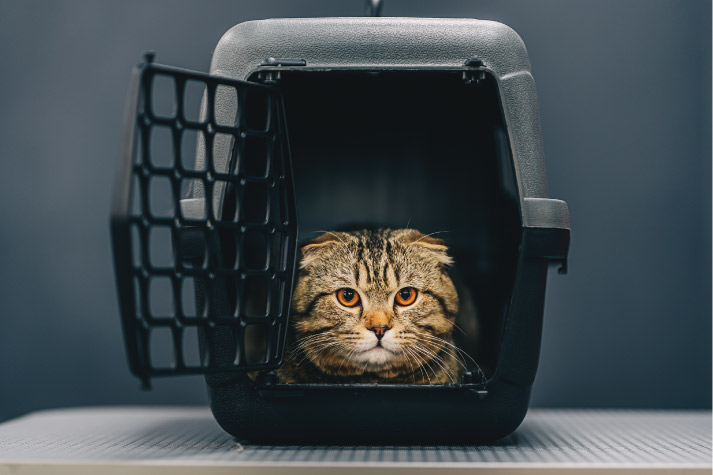


13 Mar
While it isn't the first thing that springs to mind, a carrier or crate is an important accessory for a cat owner. When making the basic set of purchases for a new cat like bowls, toys, food, and scratching pads, one of the most overlooked accessories is a pet carrier that will ease your movement and help you comply with rules and regulations when embarking on pet travel in the UAE.
It might not sound like much, but a pet carrier is important when you’re travelling through places where you cannot control the environment. For example, if you’re in a car with your unrestrained cat, and your cat is startled by cars honking or other stimuli, they can react unpredictably and increase the risk of an accident. Such carriers are also useful when introducing your cat to a new space, when travelling to the vet, or even when boarding a flight with your cat. You’ll need a carrier to travel with your cat in the UAE as well, so it is an important accessory.
However, choosing the appropriate carrier for your cat is not as straightforward as you may think. With a plethora of options available, it can be a challenge to select the appropriate cat carrier. Each cat and their owner is different, and each cat and their owner has different requirements and uses for their carrier. Regardless of your preferences or usage case though, there are a few criteria that you should consider if you’re planning your purchase.
When you’re browsing through the various choices for a kitty carrier, you should always pay attention to the safety features offered, the construction of the carrier, and the durability on offer thanks to the build and materials. Generally, you should opt for a carrier made of a sturdy plastic or metal wire mesh, or you could go the secure route and choose an IATA-Approved Pet crate which will save you the trouble of buying a separate crate for air travel from the UAE. Avoid fabric carriers, as while these are pretty to look at, your cat may be able to push their way out of a zipper-chain compartment, and their notoriously sharp claws will make short work of any non-reinforced fabrics.
Different cat carriers and crates have different entry points. Carriers are generally top or front-opening to ease your cat’s entry and exit from the carrier. If your cat is not crate-trained, it is recommended you acquire a carrier with both top-opening and front-opening mechanisms. Front-opening carriers will have the added benefit of being able to take the entire top off, which makes it easier still to take your cat in and out of their carrier. This can either be very useful or not useful at all, depending on whether your cat is nervous and anxious or comfortable. Vets find these handy.
A carrier’s size is another important parameter to consider before making a purchase. Your carrier of choice must be large enough for your cat to stand up, turn around, and lie down in a comfortable and relaxed manner. However, it must not be large to the point where your cat feels anxious or lost in it. If you have a kitten, then most carriers will probably be far too large, in which case you can line the carrier with absorbent mats or a comforter to make it feel more homely. As your cat grows, be sure to adjust their carrier size along with them, and to provide crate/carrier training to help them in social situations and while on pet travel.
Your cat’s carrier will require some maintenance, so it is useful to buy one which makes the job easier. Plastic, hard-shelled carriers are easier to clean than fabric carriers, and can often be wiped down for quick cleaning. Fabric carriers will be difficult to clean since the fabric will need to be washed to be fresh again and trying to rid a fabric of pet pee/poop is not a quick process. If you're using the carrier for frequent vet visits, avoid a fabric carrier.
Cats like privacy. When nervous, they will often seek a quiet, secluded corner to feel safe and secure. Therefore, your carrier should give your cat some measure of privacy without obstructing or limiting their airflow while inside it. It can be a challenge to find such a carrier since the ventilation is often given priority (rightly so), but you can always fix it with a DIY solution; drape a towel or affix a thin cloth on the sides of your carrier so your cat can have their privacy and avoid being motion sick as well.
To conclude, there is a plethora of carrier options available to you as a pet parent. Each will have certain perks and a few cons, so make sure to do your research and select the correct carrier for your pet. Provided you remember that your pet’s comfort is the priority and choose the correct size of crate/carrier, you should have no problems with your choice of carrier.

AUTHOR’S BIO
ARSH BHARDWAJ
I am passionate about language, storytelling and the human urge to connect Having paid close attention to marketing and branding as a craft for some time, I'm eager as ever to indulge my passion for prose.